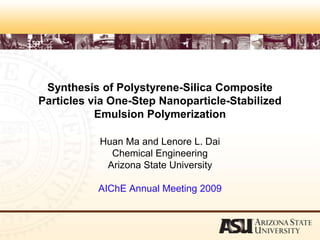
1. Synthesis of Polystyrene-Silica Composite Particles via One-Step Nanoparticle-Stabilized Emulsion Polymerization
- 1. Synthesis of Polystyrene-Silica Composite Particles via One-Step Nanoparticle-Stabilized Emulsion Polymerization Huan Ma and Lenore L. Dai Chemical Engineering Arizona State University AIChE Annual Meeting 2009
- 2. 2 Polymer Composites Wide applications Automotives Aircrafts Electronic devices Sports equipments Paints Food packages … Advanced properties Mechanical Thermal Electrical Optical …
- 3. 3 Polymer Composites Polymer Traditional Composites + Inorganic Particles NewPolymer Composites Core-Shell Composite Particles How About? Traditional Polymer Composites vs. Core-Shell Composite Particles
- 4. 4 One-Step Nanoparticle-Stabilized Emulsion Polymerization nanoparticle-stabilized emulsion polymerization Inorganic Particles Pickering Emulsions (using solid nanoparticles as stabilizer)
- 5. 5 electrostatic attractions cationic initiators nanoparticles ( - ) nonionic initiators x Synthesis of Polystyrene-SilicaComposite Particles Emulsion polymerization No success has been reported using nanoparticles as the sole stabilizing agent Dispersion polymerization Solely stabilized by silica nanoparticles Cationic initiator AIBA – core-shell structure (up to 29 % silica) Nonionic initiator AIBN – poor coverage (up to 1.1 % silica) Really impossible??? A. Schmidet al., Chem. Mater.2007, 19, 2435-2445
- 6. 6 Objectives Synthesize core-shell structured polystyrene-silica composite particles by emulsion polymerization with a nonionic initiator, using silica nanoparticles as the sole stabilizing agent Characterize particle size, morphology, and composition Track the change of particle size and surface coverage with reaction time at various initiator concentrations
- 7. Materials Monomer: Styrene 99.9 %, Fisher Continuous phase: Water HPLC, AcroOrganics Nanoparticle: IPA-ST 10-15 nm silica nanoparticles dispersed in isopropanol 30-31 wt%, Nissan Chemicals Initiator: VA-086 Azobis[2-methyl-N-(2-hydroxyethyl)propionamide] Water-soluble Nonionic 98 %, Wako Chemicals 7
- 8. 8 Why Initiator VA-086? No success has been reported in surfactant-free emulsion polymerization of styrene Synthesis without silica nanoparticles Opaque product (low conversion) No particle formation was observed The initiator VA-086 has little effect on stabilizing an emulsion polymerization system Silica nanoparticles are the only source of stabilizers when present The system do not contain surfactants nor auxiliary co-monomers 200 nm
- 9. 9 Synthesis Styrene in water emulsion stabilized by silica nanoparticles Composite particles N2 Add VA-086 solution At least 3 h 70 oC Wash* Characterization * Two centrifuging-redispersing cycles: centrifuge at 7000 rpm for 5 minutes at 23 oC and redisperse by manual shaking
- 10. 10 Particle Morphology and Size Distribution(TEM, SEM, EDX, and DLS) VA-086: 0.06 g Styrene: 8 mL IPA-ST: 20 g (dried silica 6 g; 2-propanol 14 g) Water: 52.5 g Reaction time: 5 h 200 nm 200 nm 2 µm
- 11. 11 Silica Content(TGA) Composite particles 200 nm HF treated particles †A. Schmidet al., Chem. Mater.2007, 19, 2435-2445 The nanoparticles are thermodynamically favorable to self-assemble at the liquid-liquid interfaces, even in the absence of electrostatic interactions 200 nm
- 12. 12 Glass Transition Temperature(DSC) Polymer immobility at silica surface Attractive interaction Tg increase Experimental results: Composite particles: Tg = 103.8±0.2oC HF treated particles: Tg = 100.7±0.0 oC Reference results: Depending on the silica nanoparticle source, either slightly elevated Tg or depressed Tg was observed in polystyrene-silica composite particles M. J. Percy et al., Langmuir2004, 20, 2184-2190.
- 13. 13 Particle Size and Surface Coverage 24 h 11 h 3 h Initiator/monomer 0.83 wt% 2.5 wt% 4.2 wt%
- 14. 14 Conclusions Polystyrene-silica core-shell structured composite particles with silica content up to 20 wt% were successfully synthesized by emulsion polymerization using nonionic initiator VA-086 Silica nanoparticles act as the sole stabilizer during the polymerization, following the same mechanism in solid-stabilized emulsions When the silica/monomer ratio is increased from 0.83 wt% to 2.5 wt%, the particle size at 24 hour reaction time decreases for a fixed monomer amount, probably due to a larger number of nuclei at the initial stage of polymerization Further increasing the initiator/monomer ratio to 4.2 wt% does not continually decrease the particle size, which might be limited by stabilization provided by a fixed concentration of silica nanoparticles The surface coverage also changes with the reaction time and the initiator concentration, but the underlying mechanism is still not fully understood
- 15. 15 Acknowledgements The Department of Chemical Engineering, the Department of Chemistry, and the Imaging Center at Texas Tech University NSF funding (CBET-0918282)